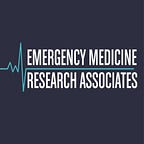EM Resident Conference by Vaibhavi Patankar (7.14.20)
Last week I had the privilege of attending an Emergency Medicine Departmental Conference that featured presentations on treatment for the consumption of toxic substances, as well as case studies that highlighted the assessment of patients with complex diagnoses. The conference began with a presentation called “Significant Figures” which discussed the importance of weighing the number needed to treat and the number needed to harm. The “number needed to treat” refers to a quantitative measure of the benefit a particular therapy poses. It is calculated by determining the number of people that need to be treated for that treatment option to be viable and considered optimal. Often, we believe that treating a patient is the right course of action yet in some cases this may do more harm than good. For intercranial hemorrhages, for example, treatment can cause unintentional harm. The “number needed to harm” and “number needed to treat” vary according to the gravitas of situation and medical condition which is why the presentation sparked discussion among the residents and faculty. Listening in on the discussion from the sidelines allowed me to acknowledge and marvel at the multitude of perspectives present within physicians belonging to the same department and hospital. I realized that varying thought processes are a product of one’s experiences, cultures, environments and that facilitating collaboration in the medical community is fundamental to progress. I was able to see this sense of partnership among the residents in the meeting who were tasked with formulating a treatment plan for a fictional patient based on imaging and medical records presented to them. I watched as the residents interpreted EKGs and chest X-rays, noting ST elevations and signs of cardiomegaly. In addition, the conference included a presentation by Dr. Michael Levine who discussed the most effective methods for treating common conditions caused by the consumption of toxic substances, the target organs affected, and the chemical nature of the substances that contribute to their toxicity. The major compounds he discussed included methanol, ethyne glycol, and isopropanol which can be found in windshield fluids, antifreeze, and nail polish or industry solvents respectively. I was surprised to know that many household items contained these substances which furthers the need to educate the public about the toxicity of these compounds. Dr. Levine mentioned that while isopropanol is high in toxicity and can cause gastritis, methanol and ethyne glycol are fairly mild in toxicity. Ethyne glycol consumption can cause hypocalcemia, hypotension, and central nervous system leukocytosis while methanol, whose metabolites are more toxic than the compound itself, can cause blindness. Prominent treatment options for these conditions include ethanol drips, hemodialysis, salt treatments to correct metabolic acidosis. I particularly enjoyed Dr. Levine’s presentation because he discussed the anion gap and the trends it exhibits over time as well as the importance of MSDS databases, something I recently learned about in my organic chemistry class. As students we sometimes lose sight of the overarching purpose of the information we are learning, and instead memorize only to regurgitate on an exam. But seeing the knowledge I had gained from my classes be applied to medical practice only served to instill a newfound appreciation for concepts that I had believed to be tiresome at the time.
